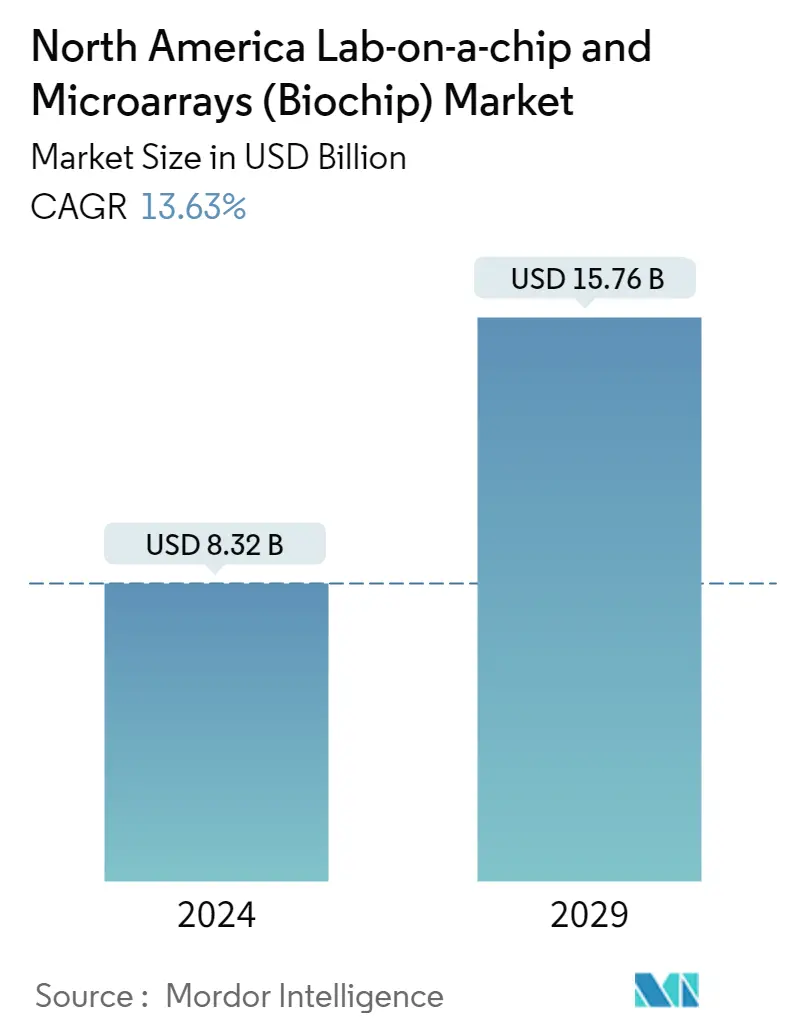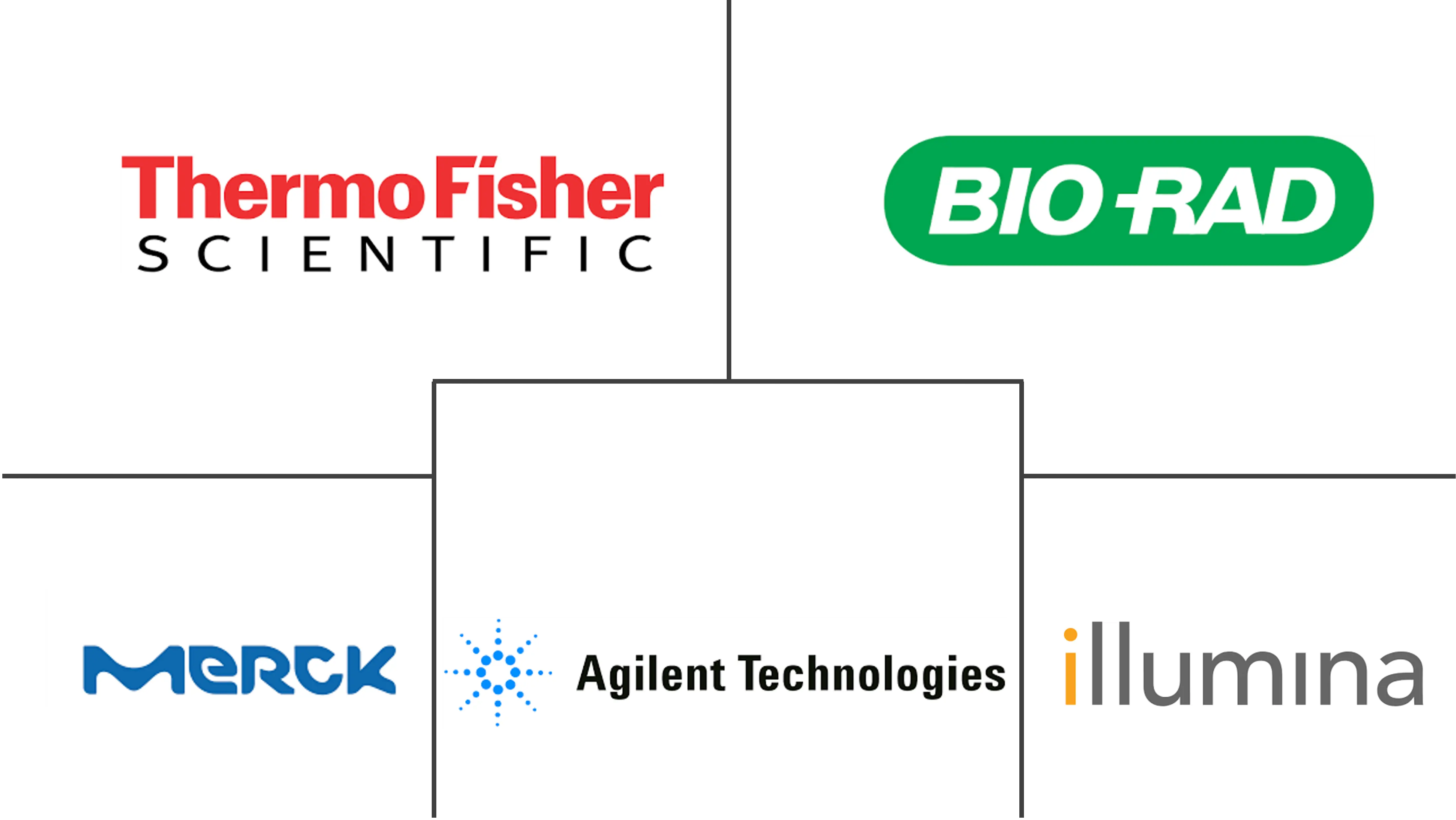Market Size of North America Lab-on-a-chip and Microarrays (Biochip) Industry

| Study Period | 2019 - 2029 |
| Base Year For Estimation | 2023 |
| Forecast Data Period | 2024 - 2029 |
| Market Size (2024) | USD 8.32 Billion |
| Market Size (2029) | USD 15.76 Billion |
| CAGR (2024 - 2029) | 13.63 % |
Major Players
*Disclaimer: Major Players sorted in no particular order |
North America Lab-on-a-chip & Microarrays Market Analysis
The North America Lab-on-a-chip and Microarrays Market size is estimated at USD 8.32 billion in 2024, and is expected to reach USD 15.76 billion by 2029, growing at a CAGR of 13.63% during the forecast period (2024-2029).
- The COVID-19 pandemic had a significant impact on the market under study because healthcare services dramatically increased due to their involvement in analyzing various biological samples. Microfluidics provided quick and reasonably priced point-of-care diagnostic instruments for COVID-19 diagnostics, which remained essential in controlling the pandemic and helped with COVID-19 diagnosis. Hence, microfluidics played a pivotal role during the pandemic phase.
- Additionally, as per an article published in December 2021 in the Viruses Journal, a microarray-based technique was created by researchers in Russia to identify immunoglobulin G (IgG) and immunoglobulin M (IgM) antibodies against type I interferons (IFN-Is), betacoronaviruses (SARS-CoV-2, SARS, MERS, OC43, and HKU1), and other respiratory viruses. This multiplex assay was used to monitor antibody cross-reactivity caused by prior exposure to comparable viruses and to pinpoint antibodies against IFN-Is as the indicators for severe COVID-19. Such research during the later phases of the pandemic fueled the adoption of microfluidics and micro-array technology for detection, leading to significant growth in the market.
- In the current times, where everything is normalized to pre-covid levels, diagnostics procedures are regularly operating, increasing the demand for microarrays. This is expected to further drive the market growth over the forecast period.
- Factors such as an increasing application of proteomics and genomics in cancer research, technological advances in microfluidics materials, and the growth of personalized medicine are anticipated to fuel the market growth over the analysis period.
- The incidence of chronic diseases is increasing the healthcare burden in countries across North America, including Canada and Mexico. For instance, as per the statistics provided by the Heart and Stroke Foundation of Canada (HSFC) in February 2022, around 750,000 people were living with heart failure in 2021, and nearly 100,000 people are diagnosed with this incurable condition each year in Canada. Thus, this statistics shows that there is a burden of CVD and associated diseases in the country, and this is further expected to increase the need for the availability of advanced CVD detection tools.
- The need for microfluidics to identify cardiovascular illnesses is rising due to the effectiveness of microfluidics devices in multiplexing the capture of several cardiac biomarkers at clinically significant concentrations. Thus, the increasing burden of chronic diseases is fueling the growth of the lab-on-chip market, as it can offer a high-throughput screening of these diseases.
- However, factors such as low commercial acceptability due to the high costs and lack of skilled labor are predicted to hinder market growth.
North America Lab-on-a-chip & Microarrays Industry Segmentation
As per the scope of the report, a biochip is a collection of miniaturized test sites (microarrays) arranged on a solid substrate that permits many tests to be performed simultaneously to achieve higher throughput and speed. Typically, a biochip's surface area is no larger than a fingernail. Like a computer chip that can perform millions of mathematical operations in one second, a biochip can complete thousands of biological reactions, such as decoding genes, in a few seconds.
The North America lab-on-a-chip and microarrays (biochip) market is segmented by type (lab-on-a-chip, microarray), product (instruments, reagents and consumables, and software and services), application (clinical diagnostics, drug discovery, genomics and proteomics, other applications), end-user (biotechnology and pharmaceutical companies, hospitals and diagnostics centers, academic and research institutes) and geography (United States, Canada, Mexico).
The report offers the value (in USD million) for the above segments.
| By Type | |
| Lab-on-a-chip | |
| Microarray |
| By Product | |
| Instruments | |
| Reagents and Consumables | |
| Software and Services |
| By Application | |
| Clinical Diagnostics | |
| Drug Discovery | |
| Genomics and Proteomics | |
| Other Applications |
| By End User | |
| Biotechnology and Pharmaceutical Companies | |
| Hospitals and Diagnostics Centers | |
| Academic and Research Institutes |
| Geography | |
| United States | |
| Canada | |
| Mexico |
North America Lab-on-a-chip and Microarrays (Biochip) Market Size Summary
The North America lab-on-a-chip and microarrays market is poised for significant growth, driven by advancements in microfluidics and the increasing application of these technologies in healthcare diagnostics. The market's expansion is largely attributed to the heightened demand for rapid and cost-effective diagnostic tools, particularly during the COVID-19 pandemic, where microfluidics played a crucial role in point-of-care testing. As healthcare services normalize to pre-pandemic levels, the demand for microarrays is expected to rise, fueled by their application in proteomics and genomics, especially in cancer research. The growing burden of chronic diseases in North America, such as cardiovascular conditions, further propels the need for advanced diagnostic tools that can offer high-throughput screening capabilities. Despite challenges like high costs and a shortage of skilled labor, the market is set to benefit from technological advancements and the increasing adoption of personalized medicine.
The United States holds a dominant position in the North American lab-on-a-chip and microarrays market, supported by a robust drug development infrastructure and rapid technological advancements. The demand for these technologies is bolstered by the need for efficient tumor detection tools, given the rising incidence of brain tumors and other cancers. Strategic activities such as mergers, acquisitions, and product launches by key market players are expected to drive further growth. The competitive landscape is characterized by the presence of major global and regional players, including Abbott Laboratories, Bio-Rad Laboratories, and GE Healthcare, which collectively hold a substantial market share. Innovations in product development, such as the launch of new testing packages and international research collaborations, are anticipated to enhance market dynamics and promote growth throughout the forecast period.
North America Lab-on-a-chip and Microarrays (Biochip) Market Size - Table of Contents
-
1. MARKET DYNAMICS
-
1.1 Market Overview
-
1.2 Market Drivers
-
1.2.1 Increasing Application of Proteomics And Genomics in Cancer Research
-
1.2.2 Technological Advances in the Materials in Microfluidics
-
1.2.3 Growth of Personalized Medicine
-
-
1.3 Market Restraints
-
1.3.1 Lack of Standardization
-
1.3.2 Availability of Alternative Technologies
-
-
1.4 Porter's Five Forces Analysis
-
1.4.1 Threat of New Entrants
-
1.4.2 Bargaining Power of Buyers/Consumers
-
1.4.3 Bargaining Power of Suppliers
-
1.4.4 Threat of Substitute Products
-
1.4.5 Intensity of Competitive Rivalry
-
-
-
2. MARKET SEGMENTATION (Market Size by Value - USD million)
-
2.1 By Type
-
2.1.1 Lab-on-a-chip
-
2.1.2 Microarray
-
-
2.2 By Product
-
2.2.1 Instruments
-
2.2.2 Reagents and Consumables
-
2.2.3 Software and Services
-
-
2.3 By Application
-
2.3.1 Clinical Diagnostics
-
2.3.2 Drug Discovery
-
2.3.3 Genomics and Proteomics
-
2.3.4 Other Applications
-
-
2.4 By End User
-
2.4.1 Biotechnology and Pharmaceutical Companies
-
2.4.2 Hospitals and Diagnostics Centers
-
2.4.3 Academic and Research Institutes
-
-
2.5 Geography
-
2.5.1 United States
-
2.5.2 Canada
-
2.5.3 Mexico
-
-
North America Lab-on-a-chip and Microarrays (Biochip) Market Size FAQs
How big is the North America Lab-on-a-chip and Microarrays (Biochip) Market?
The North America Lab-on-a-chip and Microarrays (Biochip) Market size is expected to reach USD 8.32 billion in 2024 and grow at a CAGR of 13.63% to reach USD 15.76 billion by 2029.
What is the current North America Lab-on-a-chip and Microarrays (Biochip) Market size?
In 2024, the North America Lab-on-a-chip and Microarrays (Biochip) Market size is expected to reach USD 8.32 billion.

